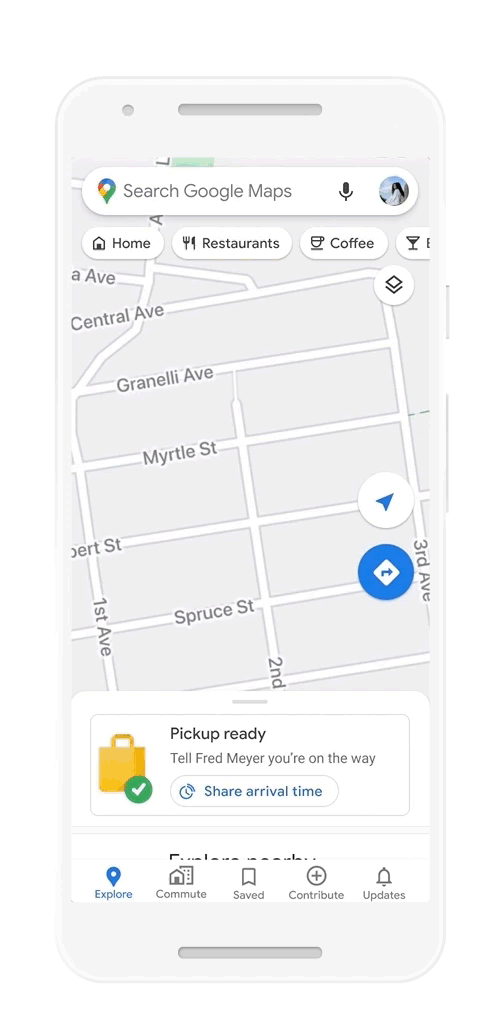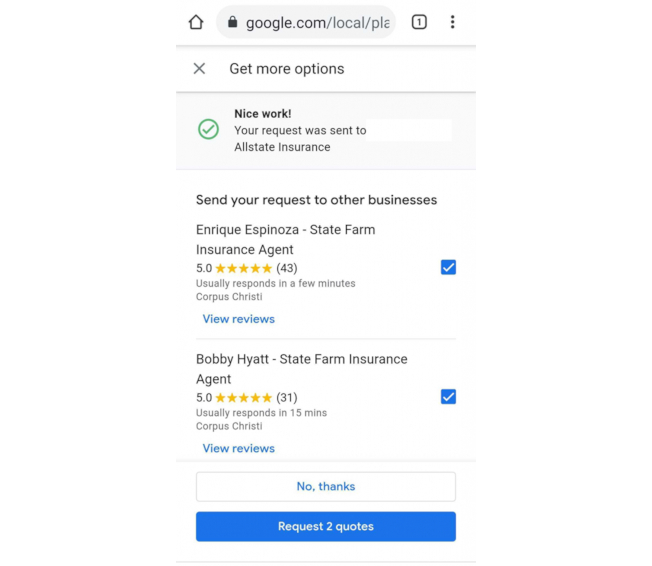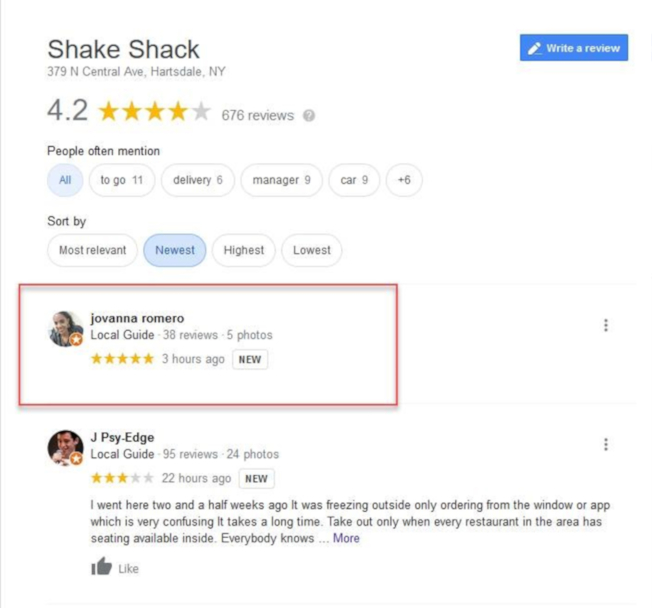As 2021 gets into full swing, so too do the changes in local search. Join us for a quick rundown of all the updates you need to know about, from enhanced delivery/pickup features to a shiny new local two-pack. Let’s go!
Google reveals local search trends amid COVID-19
With the profound impact the pandemic is having on local businesses, Google has released its research on the topic: Local is now digital: Understanding the new local shopper. The search giant explores why storefront signage is no longer a reliable business generator and explains how marketing to local customers has become as digital as marketing to audiences that would never physically visit a store. In other words, COVID has accelerated the digitization of marketing (and the economy) by several years.
There are a number of interesting points that are bought up in Google’s research, with highlights including:
- Searches for “local” + “business(es)” have grown by more than 80% year over year, including searches like “local businesses near me” and “support local businesses”
- Searches for “who has” + “in stock” have grown by more than 8,000% year over, including searches like “who has Nintendo Switch in stock” and “who has gym equipment in stock”
- Two out of three dining consumers said they used search to find food and beverage information during the pandemic
- Searches on Google Maps for “curbside pickup” have increased nearly 9,000% year over year in the US
- Searches on Google Maps for “discounts” have grown by more than 100% year over year globally
- Searches on Google Maps for “gift shop” have grown by more than 60% year over year globally
The last two points, “discounts” and “gift shop”, are a little surprising, aren’t they? Their rising popularity suggests that more people are looking at general gift or shopping ideas online rather than trying to find specific items. If you can capitalize on this trend and incorporate these terms into your content, it will likely be worth the effort. After all, even when in-person shopping returns in full force, its digital counterpart isn’t going to give up its pandemic gains.
Goodbye, three-pack; hello, two-pack
Google has begun testing a two-pack format, rather than three-pack, for local queries on mobile. If fully implemented, this change will supercharge businesses in those spots but force those in third position below the fold. We already know that jumping from fourth to third is one of the greatest single SEO gains, but it looks like only gold and silver will matter soon.
This change also emphasizes the fact that paid ad placements occupy the most valuable SERP real estate. In the below example, “Alan David Custom Suits” occupies positions 1, 2, 3, and 5—a complete domination of all top results, both paid and organic.

Credit: Local University
This is still only a test, but businesses should continue to follow established best practice in SEO. The goalposts just got smaller, but you still need to set up location pages and ads to work in tandem with one another if you want to thrive in local search.
Google enhances business profiles for stores with delivery and pickup
This month, Google announced another feature meant to compensate for the absence of in-store shopping: improved visibility for curbside pickup and delivery options within Google Search and Maps.

Credit: Google
The new information Google is adding to applicable businesses includes:
- Delivery providers
- Pickup and delivery windows
- Order fees
- Order minimums
Google will first start rolling this information out on mobile searches for grocery delivery provided by Instacart and Albertsons in the US, but plans to expand this feature to other countries and delivery partners in the near future. In the interim, the search giant is pulling qualifying store information from the business profiles grocery chains already have with these two delivery providers. Because it’s an automatic process, business owners are encouraged to review the details to ensure accuracy.
Google rolls out product reviews algorithm update
While not a “core” algorithm update, Google’s new product reviews algorithm update is having a fundamental impact on sites that display that type of content. The ubiquity of product-related queries like “best digital cameras 2021” forced Google to recognize that its algorithm was struggling to effectively deliver this type of content.
Unsurprisingly, there are plenty of bad actors out there who publish product-focused “listicles” only for their SEO benefits and not because they’ve genuinely evaluated the products. These reviews often promote specific brands or are identical from year to year with only the date changed. In response, Google explained that this update is:
…designed to better reward product reviews that share in-depth research, rather than thin content that simply summarizes a bunch of products. Insightful analysis and original research will be rewarded and especially content written by experts or enthusiasts who know the topic well.
This update will hopefully drive additional traffic to the right kinds of reviews and take power away from influencers with little expertise other than how to game the algorithm.
Google knowledge panel emphasizes competitors
In a potentially pro-consumer but anti-business move, the Google knowledge panel may display competitors as alternatives to your business. There have also been reports of Google prompting users to send quote requests to competitors after they request a quote from their initial choice.

Google My Business (GMB) users have no control over the knowledge panel, so this change may only discourage businesses from offering quotes via Google Messaging. After all, customers that interact with your listing have high intent—so why risk diverting that intent to a competitor they may not have even considered until submitting a quote request? It may be better to facilitate quote requests via a different mechanism; one that won’t redirect your hard-earned leads to a rival.
Phone numbers banned from Google Posts
Google updated its Google Posts content policy to specifically disallow the inclusion of phone numbers within Posts. On the topic of “phone stuffing”, Google wrote:
To avoid the risk of abuse, we do not allow your post content to include a phone number. You can make your phone number available on your Business Profile or website. Instead, you can attach a “Call now” button to your post that uses your verified Business Profile phone number.
While a minor change and one that does not prevent the inclusion of a phone number as part of a Google Post’s image, it is something that business owners should keep in mind. If you have recent Google Posts that failed to publish on your listings, this may be the reason why.
“New” label for local reviews (and no more star-only ratings on mobile)
Back in December, Google tested a “new” label for local business reviews less than a month old. That new label is now live in local reviews for all to see:

In addition, GMB listings on mobile are no longer displaying reviews without text content. Star ratings from textless reviews are still factored into the average rating, of course, but Google no longer considers them valuable enough to display on mobile. As you can see in the example below, the textless five-star review has disappeared:

These two updates highlight Google’s preference for recent, descriptive reviews. In fact, the search giant is already using review content to organize review topics, highlight snippets for the local pack, and even understand which businesses should be displayed in specific SERPs. As always, all businesses should encourage a constant flow of positive reviews not just for their inherent value to consumers but to satisfy Google’s algorithms and reap the rewards accordingly.
Photo updates on Google Maps
Google recently announced it would support a new content type on Google Maps listings: the Google Maps photo update. A photo update is a recent snapshot of a place with a short text description. These photos live in the “Updates” tab on mobile GMB profiles—and don’t need to be accompanied by a review or rating.
Businesses are always encouraged to post interior, exterior, logo, and product images on their listings, especially now that Google’s “Vision AI” is able to detect the content and text within these images and conjure them up for relevant user queries. Sooner or later, local businesses may need to solicit user photos in the same way they solicit reviews today.
Local search moves fast, but we move faster. Find out how our bespoke local search products and services can help your brand reach the right customers with the right message at the right time. Let’s talk!




